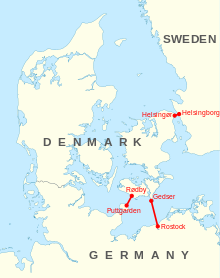Scandlines
This article needs to be updated. (November 2018) |
This article includes a list of general references, but it remains largely unverified because it lacks sufficient corresponding inline citations. (August 2021) |
| Type | Private |
|---|---|
| Industry | Transport |
| Founded | 1998 |
| Headquarters | Copenhagen , Denmark |
Number of locations | Two routes |
Area served | Baltic Sea |
| Services | Ferries |
| 477 million EUR (2018) | |
| Owner | First State Investments, Hermes Investment Management and 3i Group |
| Parent | Scandferries Holding ApS |
| Divisions | Scandlines Deutschland GmbH, Scandlines Danmark ApS |
| Website | Official website |
Scandlines is a ferry operator owned by a consortium consisting of First State Investments, Hermes Investment Management, and equity investor 3i Group. Scandlines operates two lines for passenger and freight in and between Denmark and Germany (Rødby–Puttgarden and Gedser–Rostock). Scandlines services to Sweden were served in co-operation with Stena Line, but in 2015, Stena Line and Scandlines sold their shares to the investment fund First State.
The parent company is Scandferries Holding ApS, with headquarter in Copenhagen, Denmark, with a German subsidiary named Scandlines Deutschland GmbH situated in Hamburg, and a Danish subsidiary named Scandlines Danmark ApS, situated in Copenhagen.[1]
History[]
Scandlines used to be co-owned by the Danish Ministry of Transport (50%) and Deutsche Bahn AG (50%),[2] but as of June 2007, it was sold to a consortium consisting of 3i Group of London (40%), Allianz Capital Partners (ACP) of Munich (40%), and of Rostock (20%). The consortium bought Scandlines for a total of 1,560 million euros. On 29 October 2010, DSR's 20% share of Scandlines was acquired by 3i Group and ACP. At the end of 2013 3i Group acquired ACP's stake for 165 million euros, becoming the sole owner of Scandlines.
Since 2018, Scandlines has been owned by a consortium consisting of 3i, First State Investments, and Hermes Investment Management.
With a total of six hybrid ferries (four operating on Rødby–Puttgarden and two on Gedser–Rostock), Scandlines is the owner of the world's largest hybrid ferry fleet.
Scandlines also owns the world's largest hybrid ferries, the M/V Berlin and M/V Copenhagen.[3]
Routes[]

Two routes across the Baltic Sea are driven under the Scandlines brand.
| Route | Crossing time |
|---|---|
| Puttgarden–Rødby | 45 mins |
| Rostock–Gedser | 1 hr 45 mins |
Fleet[]

Scandlines operates eight ferries of which six are hybrid.[4]
| Name | Built | Tonnage | Passengers | Notes |
|---|---|---|---|---|
| Gedser–Rostock | ||||
| Berlin | 2016 | 22,319 | 1,300 | hybrid ferry |
| Copenhagen | 2016 | 22,319 | 1,300 | hybrid ferry, incl Rotor sail |
| Rødby–Puttgarden | ||||
| Prins Richard | 1997 | 14,822 GT | 1,140 | hybrid ferry |
| Prinsesse Benedikte | 1997 | 14,822 GT | 1,140 | hybrid ferry |
| Schleswig-Holstein | 1997 | 15,187 GT | 1,200 | hybrid ferry |
| Deutschland | 1997 | 15,187 GT | 1,200 | hybrid ferry |
| Holger Danske | 1976 | 2,779 GT | 12 | only dangerous goods |
| Kronprins Frederik | 1981 | 16,071 GT | 1,082 | only freight |
References[]
- ^ "Scandlines.dk".
- ^ "Scandlines Deutschland GMBH – Company Structure". Retrieved 2006-12-18.
- ^ "Scandlines.dk".
- ^ "Scandlines.dk".
Sources[]
6 "Scandlines and FAYRAD sign contracts[1]
External links[]
| Wikimedia Commons has media related to Scandlines. |
- Ferry companies of Denmark
- Ferry companies of Germany
- 3i Group companies
- Companies based in Mecklenburg-Vorpommern
- Transport companies established in 1998